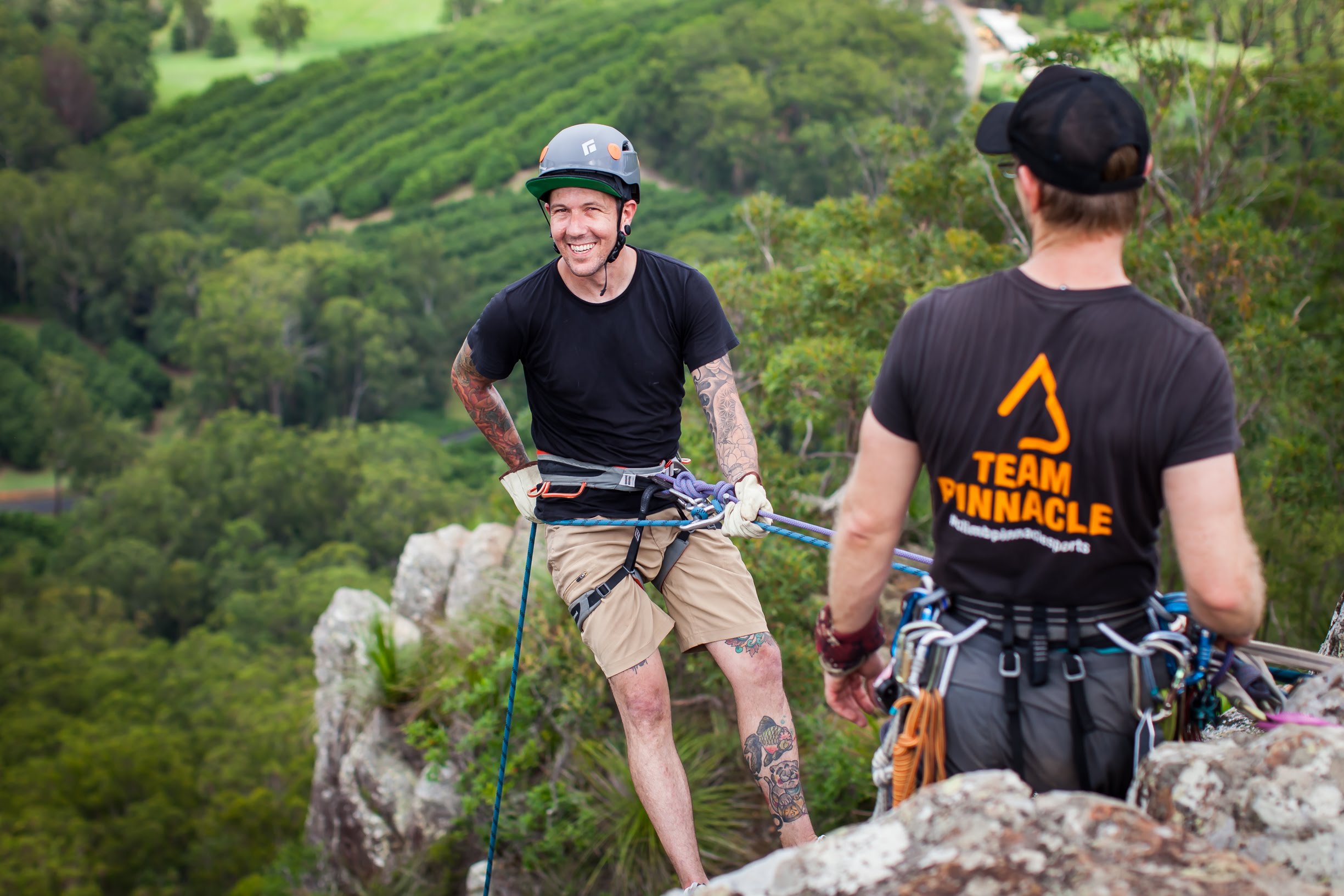https://www.pinnaclesports.com.au/ambassadors#RyanMoragWritten by Pinnacle Ambassador Ryan Siacci

Being the second tallest mountain in Bolivia at 6438m, and the tallest in the Cordillera Real, Illimani was always going to be an ambitious objective. Dominating the skyline of La Paz, this broad massif issues forth a siren song that cannot fail to be heard by anyone with climbing in their veins.
We certainly heard it clearly, though our excitement was tempered by reserve. One of our team members, my long-time accomplice and partner in suffering Adam McKenney, did not have the luxury of time. Even the mere two weeks vacation he had wrangled from the miserly clutches of corporate life was considered a major coup, so naturally we wanted to try to squeeze every last ounce from the trip. Go big or go home, as our late friend Bill Winters used to say.
We started the trip in Peru on the Salkantay Trek, and would use this as an acclimatisation period for our mountaineering phase in Bolivia. It was determined that Illimani was the desired objective. With the summit almost 2km taller than our high point on the trek, we acknowledged that it was a bold plan with little room for error.
The other team members, consisting of Morag Stewart, Josh Worley and myself, drove from Cusco to La Paz, whereas Adam flew. We arrived in time for one of Bolivia’s largest parades: the Gran Poder festival which occurs each May. Of all the streets in La Paz which might have been blocked off for a parade, it just so happened to be ours. It was pure bedlam, a cacophony of tubas and bass drums serenading an entire city of drunks for the better part of 20 hours.
The following day we organised rations, maps, batteries, fuel and all the ordinary minutiae of a mountaineering expedition. We filled our gargantuan packs with equipment and then enjoyed a rest day before heading out to the hamlet of Pinaya, nestled in the foothills of Illimani.

For our climbing timeline, we were using the standard three-day ascent employed by most guided parties. The first day of the expedition includes the drive to the mountain, and with good reason - Bolivian roads are not to be taken lightly. Depending on the availability of internet, we alternate between Google Maps and Maps.Me, the latter of which is available offline but has less intuitive navigational skill than a blind cavefish. It will take you on the absolute shortest route by distance only, regardless of traffic, roadworks, civil blockades, lava, landslides, floods, or even enormous 20 hour parades celebrating Baby Jesus.
So it was that we ended up on some truly scary roads in the Bolivian backcountry. I’ve not yet driven the Death Road, but it’s hard to imagine it being much worse than these. The terror factor must have been amplified for Adam who did not have the benefit of a real seat, and instead had to sit in the back of the van on a Crazy Creek camp chair, sliding back and forth with the occasional 500m drop yawning below his window view. “Steady as she goes” was the aim of the game, and we mercifully returned to the valley floor before fording a minor river and climbing once more to find the small village.
Little more than a town square and a few scattered farms, we were greeted in the township of Pinaya by a cranky old man demanding money of us. Many parks have a standard 20 Boliviano fee for entry, which you may or may not be required to pay depending on whether old mate is napping or not. We were more than happy to pay for this, but less happy about the 200 Boliviano cost of parking the van. I don’t think he was particularly pleased with our reluctance to hire mules or porters and jacked up the price for parking accordingly. I felt that the cost was a bit extortionate in relative terms, but still not a heavy burden on our gringo wallets.
![]()
With the afternoon settling in, we shouldered our heavy packs and ascended into the alpine meadows. Herds of llama scattered as we arrived at Puente Roto Campo Base, a large flat area in the shadow of the almighty peak. The evening was particularly cold and we turned in early.
The real labours began the following day with a 1000m ascent to El Nido de Condores or “The Condor’s Nest”. This vantage is gained by ascending an endless spur of horrific scree where small daggers, loose slates, polished slabs and errant cairns must be endured by the beleaguered climber. It was here that I began to regret our decision to refuse assistance with load carriage. The effort intensified as I passed 5000m and the substantial weight of my pack began to deplete my energy with disquieting speed.

I was the last to reach the Condor’s Nest, our high camp at 5400m. Having gained 800m greater elevation than our high point on the Salkantay and 200m more than my previous personal altitude record, I was now experiencing some minor AMS. I had pushed too hard, too fast, and carried too much. I barely managed to keep a pack of instant noodles down, a truly pathetic dinner under the circumstances, and subsequently announced my uncertainty regarding my ability to climb.
For many, sleep was a rare commodity that night, despite surprisingly mild temperatures. Alarms sounded at 1am and I awoke from a shallow and fitful rest. I felt markedly better, though still without appetite. After a cup of coffee, we roped up and began to climb.
By default, I ended up leading the rope team. Josh had lost his glasses on the Salkantay Trek, his only remaining prescription lenses being sunglasses. Morag was embarking on her first alpine route. Adam’s headlamp, whether by cold or dodgy Bolivian batteries, was on the fritz. Although I was feeling far from perfect, I took the lead as we pushed forth into the night. It was the blind leading the literal blind.
At the very beginning, I was moving at a reasonable pace, but my steps became slower and more torturous with each vertical metre. Although still relatively simple, the terrain was more complex than I’d imagined, made difficult at times by a braided network of old tracks. We negotiated a series of long, moderate inclines, never steep enough to necessitate any technique other than French step, but on the upper limits at times. Some hours later, my pace having slowed to a crawl and my energy levels ebbing dangerously low, I stopped the team on a small rock band and threw in the towel.
“I’m toast,” I said. “Totally done. You guys can go on if you want, but I don’t have the minerals to get up and back down safely.”
There was a brief discussion and it was decided that we’d retire as a team. We were just below the headwall, some 600m below the summit. Our high point was 5800m. We turned around and descended the way we’d come, striking camp in the fledgling dawn and continuing the arduous 2000m descent to town.

When I later posted a brief update on Facebook, I stated that “an attempt is only a failure if you learn nothing from it.” So, the question remains - what did I learn? Or what important lessons was I reminded of?
I learned what it’s like not to have enough left in the tank. I’ve retreated from plenty of climbs, but the reasons have always been objective… snow conditions, weather, time concerns and the like. This was the first time I’d found myself wanting, and I realised that I had managed myself and my energy levels poorly. Having the opportunity to pull the plug before a moment of desperation was a powerful exercise in self-awareness and humility for me.
I learned to be a bit more measured with acclimatisation and not to accept other climbing schedules at face value. I also was reminded of the importance of team dynamics in this regard – there will always be stronger climbers and weaker climbers, but they share the success or failure of a climb as a team. Mountaineering, especially at high altitude, is a game of tactics, and these must be carefully considered if the game is to be won. Seemingly minor mistakes, oversights or errors of judgement have the potential to derail the entire effort.
I was reminded that it’s ok to fail. As stated earlier, we acknowledged the risk of failure inherent in attempting a tall peak in a short timeframe. We decided to have a red hot go nonetheless, and I can confidently say that failure improved me as a climber far greater than success would have.
And last of all, I was reminded of an age-old climbing maxim - that getting up is optional but getting down is mandatory. Or, as my friend Dan Peatey said regarding the attempt:
“Mountaineering is about living to suffer again, so [the attempt was] a resounding success.”
Ryan Siacci, Esq.
June 2018
Thanks to Adam McKenney and EEJCC (Wikipedia Creative Commons) for the additional images.
Looking for more great reads? Subscribe to our newsletter to stay up to date with the latest climbing tech, crag recommendations and upcoming events.










